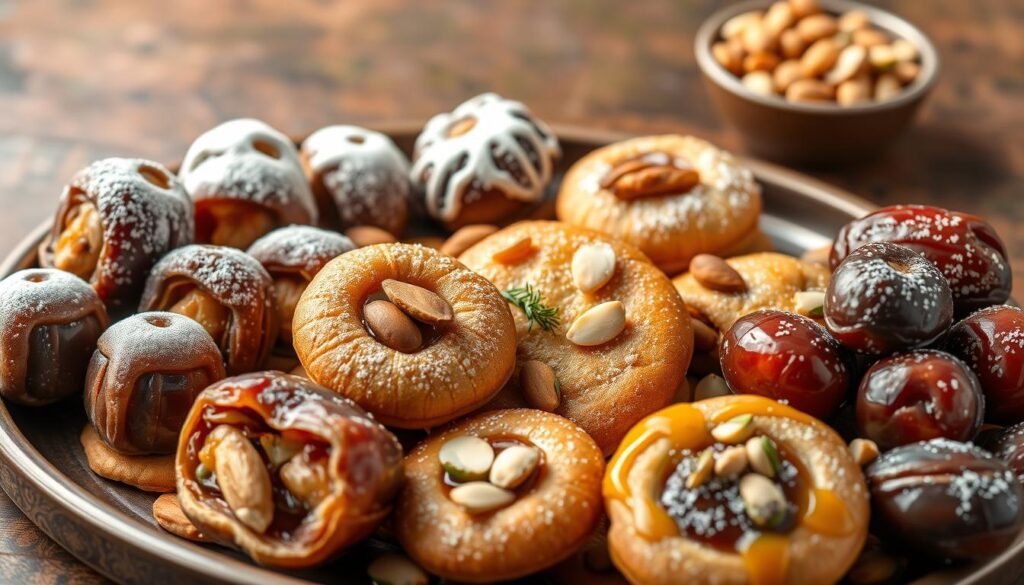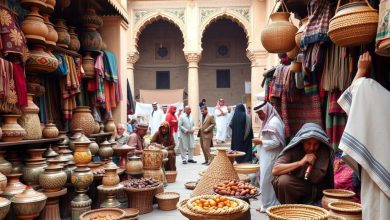A Guide to Sweet Delights – Travel and Tourism to Saudi Arabian Arabian Gulf Arabia

Exploring Saudi Arabian
Arabian
Gulf Arabian sweets is a captivating journey. You’ll find everything from rose water-infused treats to date-based desserts. These sweets offer a glimpse into the country’s rich culinary heritage.
In this guide, we’ll explore the history and cultural importance of Saudi Arabian
Arabian
Gulf sweets. You’ll learn about the flavors and techniques behind these treats. Whether you love sweets or just want to try something new, this journey is for you.
Introduction to Saudi Arabian
Arabian
Gulf Arabian Sweet Culture
The rich Arabic culinary culture is deeply intertwined with the art of confectionery. Saudi Arabian
Arabian
Gulf Arabia is a shining example of this vibrant tradition. Sweets in Saudi Arabian
Arabian
Gulf Arabia have a historic significance and play a key role in social gatherings.
Historical Significance in Arabic Culinary Traditions
The origins of Saudi Arabian
Arabian
Gulf Arabian sweet-making date back to ancient spice trade routes. Exotic ingredients like dates, rosewater, and saffron fueled a unique confectionery culture. These sweets delighted the palate and held deep symbolic meaning in Arabic culinary traditions.
Role of Sweets in Saudi Arabian
Arabian
Gulf Social Gatherings
In Saudi Arabian
Arabian
Gulf Arabian society, sweets have a cherished place. They unite people at celebrations and casual gatherings. The ritualistic presentation of sweets, with aromatic teas and coffees, turns social interactions into moments of indulgence and cultural exchange.
| Traditional Saudi Arabian Arabian Gulf Sweets |
Key Ingredients | Cultural Significance |
|---|---|---|
| Luqaimat | Flour, yeast, saffron, rose water | Served during Eid celebrations, symbolizing joy and abundance |
| Qatayef | Pancake-like dough, cream, nuts, rosewater | Enjoyed during the holy month of Ramadan, representing spiritual renewal |
| Baklava | Phyllo dough, nuts, honey, rose water | A staple in Saudi Arabian Arabian Gulf weddings, highlighting the sweetness of marital union |
The legacy of Saudi Arabian
Arabian
Gulf Arabian sweet culture is a testament to the country’s traditions. It shows the commitment to preserving flavors that have enchanted generations. Exploring Saudi Arabian
Arabian
Gulf confectionery reveals a rich history, cultural significance, and the allure of sweet delights.
Essential Ingredients in Traditional Saudi Arabian
Arabian
Gulf Desserts
Exploring traditional Saudi Arabian
Arabian
Gulf desserts reveals a world of flavors. These desserts are made with unique ingredients. A few key components give them their special taste and charm.
The date is a star in Saudi Arabian
Arabian
Gulf sweets. These sweet and nutritious fruits are used in many desserts. They are also a symbol of hospitality and culture.
Aromatic spices and floral essences add to the desserts. Rose water and orange blossom give them a fragrant elegance. These are mixed with spices like cardamom and cinnamon for a perfect flavor balance.
Nuts are also important in Saudi Arabian
Arabian
Gulf desserts. Almonds, pistachios, and walnuts add texture and richness. They make the sweets more complex and delicious.
Desserts like umm ali and rose water-infused baklava showcase these ingredients. They capture the essence of Saudi Arabian
Arabian
Gulf Arabian culinary heritage. Each bite celebrates the rich traditions and skill of Saudi Arabian
Arabian
Gulf confectioners.
Saudi Arabian
Arabian
Gulf Sweets and Desserts: A Guide to Indulging Your Sweet Tooth
Explore the rich world of traditional Saudi Arabian
Arabian
Gulf sweets and desserts. This guide will take you on a journey through Middle Eastern confectionery. You’ll discover classic favorites and modern twists.
Most Popular Traditional Treats
Saudi Arabian
Arabian
Gulf Arabia is known for its beloved desserts. Try Qatayef, a buttery pastry filled with cheese or nuts. Or enjoy Luqaimat, dough balls soaked in date syrup.
Baklava is a classic. It’s made with phyllo dough, nuts, and syrup. It’s loved by many for its sweet and flaky layers.
Regional Variations Across Saudi Arabian
Arabian
Gulf Arabia
Each region in Saudi Arabian
Arabian
Gulf Arabia has its own Arabic desserts. In coastal areas, you might find Roza, a rose custard. Or Halawet el-Jibn, a cheese pastry.
In the central heartland, try Mahalabiya, a milk pudding. Or Kunafa, a wheat pastry with cheese and syrup.
Modern Interpretations of Classic Sweets
Innovative chefs are reimagining traditional Saudi Arabian
Arabian
Gulf Arabian cuisine. They’re making Knafeh with gourmet fillings. And Date Cookies with exotic spices and chocolate.
The Art of Making Date-Based Saudi Arabian
Arabian
Gulf Sweets
Dates are a big deal in Saudi Arabian
Arabian
Gulf Arabian cuisine. They’re not just food; they’re key in making amazing desserts. These sweets show off the area’s rich cooking history and the special techniques and tastes passed down through generations.
Dates are used in many different Saudi Arabian
Arabian
Gulf sweets, each with its own special touch. From Dates-based sweets to traditional Arabic desserts, these treats are a big part of Saudi Arabian
Arabian
Gulf Arabian cuisine. They let us explore the country’s food traditions in a fun way.
Mastering the Art of Date Preparation
Creating top-notch date-based sweets starts with how the dates are prepared. Saudi Arabian
Arabian
Gulf chefs are experts at picking, pitting, and filling the dates. They use everything from nuts and spices to creamy mixtures.
- Choosing the ripest and tastiest dates
- Perfectly pitting and stuffing them
- Using creative fillings that match the dates’ sweetness
Techniques for Transforming Dates into Delectable Sweets
Saudi Arabian
Arabian
Gulf chefs use many techniques to turn simple dates into stunning desserts. They layer and mold the dates, and add spices and aromatics. Each step makes these Dates-based sweets even more special.
- Layering and molding for beautiful looks
- Adding spices and essences like cardamom and rose water
- Mixing the dates with nuts, honey, and cream
This mix of flavors and textures is amazing. It takes you on a journey through Saudi Arabian
Arabian
Gulf Arabian cuisine.

| Traditional Saudi Arabian Arabian Gulf Date Sweets |
Key Ingredients | Preparation Techniques |
|---|---|---|
| Qatayef | Dates, cream, nuts, rose water | Stuffing, layering, frying |
| Baklava | Dates, phyllo dough, nuts, honey | Layering, baking, soaking in syrup |
| Luqaimat | Dates, flour, yeast, sugar | Frying, coating in syrup |
Ramadan Special: Traditional Saudi Arabian
Arabian
Gulf Sweet Delicacies
As Ramadan starts, the smell of traditional Saudi Arabian
Arabian
Gulf sweets fills the air. These halal treats are loved by Saudi Arabian
Arabian
Gulf families. They show the rich Arabic culinary culture that has been shared for generations.
Pre-Iftar Sweet Preparations
Before the evening Iftar meal, Saudi Arabian
Arabian
Gulf homes are busy making Ramadan desserts. They make Umm Ali pastries and date-based sweets. These sweets are a special ritual, marking the end of fasting and the start of feasting.
- Umm Ali: A creamy, bread-based pudding with rosewater, nuts, and sweetened condensed milk.
- Qatayef: Crescent-shaped pancakes filled with cheese, nuts, or sweet cheese, then fried to golden perfection.
- Luqaimat: Fluffy, bite-sized dumplings coated in a sticky, sweet syrup.
Eid Al-Fitr Celebration Sweets
When Ramadan ends, Eid Al-Fitr brings more halal sweets. Families come together to enjoy traditional desserts. Each dessert shows the rich culinary heritage of Saudi Arabian
Arabian
Gulf Arabia.
- Baklava: Layers of flaky phyllo dough filled with chopped nuts and drenched in fragrant rose or orange blossom syrup.
- Kunafa: A popular pastry made with shredded phyllo dough, sweetened cheese, and soaked in a fragrant sugar syrup.
- Mehalabiya: A creamy, milk-based pudding flavored with rose water and topped with crushed pistachios.
These Ramadan desserts and Eid Al-Fitr treats are more than just sweets. They are symbols of the Arabic culinary culture that is a big part of Saudi Arabian
Arabian
Gulf Arabian lives during this special time.
Rose Water and Orange Blossom in Saudi Arabian
Arabian
Gulf Confectionery
In Saudi Arabian
Arabian
Gulf Arabian cuisine, rose water and orange blossom add a floral touch. These fragrances are key in Middle Eastern sweets, making them complex and delightful. They bring a unique elegance to traditional desserts.
Rose water and orange blossom have a long history in Saudi Arabian
Arabian
Gulf sweets. They come from the region’s rich culture, enhancing Middle Eastern confectionery and traditional Arabic desserts. These essences balance the sweetness of rose water and orange blossom pastries, making them more enjoyable.
The art of using rose water and orange blossom in Saudi Arabian
Arabian
Gulf sweets is impressive. It’s seen in rose-infused baklava and orange blossom-scented knafeh. These ingredients are woven into the sweets, creating a unique taste experience.

Rose water and orange blossom pastries are a treat in Saudi Arabian
Arabian
Gulf Arabia. They’re enjoyed at celebrations, special events, or just for fun. These pastries celebrate Saudi Arabian
Arabian
Gulf’s rich heritage and culinary skill, pleasing both locals and visitors.
Traditional Saudi Arabian
Arabian
Gulf Wedding Sweets and Customs
The vibrant Saudi Arabian
Arabian
Gulf Arabian culinary culture is deeply intertwined with marriage celebrations. At the heart of these joyous occasions are the traditional Saudi Arabian
Arabian
Gulf wedding sweets. These sweets hold immense significance in Arabic culinary traditions.
From ceremonial sweet platters to symbolic desserts, these treats play a vital role. They honor the cultural heritage and cherish the special moments of a Saudi Arabian
Arabian
Gulf wedding.
Ceremonial Sweet Platters
No Saudi Arabian
Arabian
Gulf wedding is complete without the grand display of ceremonial sweet platters. These trays are adorned with an array of bite-sized confections. Each represents a unique aspect of the celebration.
Guests are often greeted with a selection of traditional Saudi Arabian
Arabian
Gulf desserts. These include Baklava, Qatayef, and Kunafah. They are meticulously arranged to create a visually stunning presentation.
Wedding Sweet Symbolism
Beyond their delectable flavors, traditional Saudi Arabian
Arabian
Gulf wedding sweets hold deep symbolic meanings. For instance, the crescent-shaped Qamar al-Din pastries represent the moon. They symbolize the couple’s eternal love and the promise of a bright future.
The intricate Basbousa cake is often associated with fertility and prosperity. It serves as a heartfelt wish for the newlyweds. These symbolic desserts not only delight the senses but also reflect the rich tapestry of Arabic culinary culture.
The role of Saudi Arabian
Arabian
Gulf Arabian cuisine, particularly its traditional desserts, in wedding celebrations is significant. These sweet delights nourish the body and spirit. They create lasting memories and cherish the sacred bond of marriage.
Conclusion
Saudi Arabian
Arabian
Gulf sweets and desserts are a celebration of the region’s culture and sweet treats. They range from traditional date-based sweets to modern twists on classics. This world is a feast for the senses.
There’s a wide variety of sweets to try, from rose water and orange blossom to date-based treats. Saudi Arabian
Arabian
Gulf chefs and home cooks mix old techniques with new flavors. This shows their creativity and skill.
Exploring Saudi Arabian
Arabian
Gulf sweets is a chance to enjoy delicious flavors and learn about Middle Eastern confectionery. Take your time to savor each bite. Let the history and culture of these sweets deepen your appreciation for Saudi Arabian
Arabian
Gulf Arabian food.
FAQ
What are the key ingredients used in traditional Saudi Arabian
Arabian
Gulf desserts?
Saudi Arabian
Arabian
Gulf Arabian desserts often use dates, nuts, spices, and floral essences. These include rose water and orange blossom. These ingredients give these sweets their unique and complex flavors.
How do sweets play a role in Saudi Arabian
Arabian
Gulf social and cultural traditions?
Sweets are very important in Saudi Arabian
Arabian
Gulf Arabian culture. They are served at social gatherings, celebrations, and religious events. They show hospitality and mark special occasions like weddings and Eid festivities.
What are some of the most popular traditional Saudi Arabian
Arabian
Gulf sweets?
Beloved sweets include Luqaimat (deep-fried dough balls) and Qatayef (crescent-shaped pancakes). Baklava and date-based confections like Sabil and Halva are also favorites.
How do Saudi Arabian
Arabian
Gulf sweets differ across different regions of the country?
Saudi Arabian
Arabian
Gulf sweets vary by region. For example, Najd is known for intricate pastries. The Hejaz region is famous for its date-based delicacies.
What is the significance of dates in Saudi Arabian
Arabian
Gulf Arabian desserts?
Dates are key in Saudi Arabian
Arabian
Gulf sweets. They are a staple ingredient and are used as a sweetener. Various techniques are used to make different date-based confections.
How do Saudi Arabian
Arabian
Gulf sweets feature during the holy month of Ramadan?
In Ramadan, families make special sweets and desserts. These include pre-iftar treats and Eid Al-Fitr sweets. They are shared with family and friends.
What is the role of rose water and orange blossom in Saudi Arabian
Arabian
Gulf confectionery?
Rose water and orange blossom are loved in Saudi Arabian
Arabian
Gulf sweets. They add a delicate and aromatic touch. This makes Saudi Arabian
Arabian
Gulf desserts unique.
What are the traditional sweets served at Saudi Arabian
Arabian
Gulf weddings?
Saudi Arabian
Arabian
Gulf weddings feature elaborate sweet platters. These include pastries, candied nuts, and other delicacies. They are shared with guests as part of the traditions.




